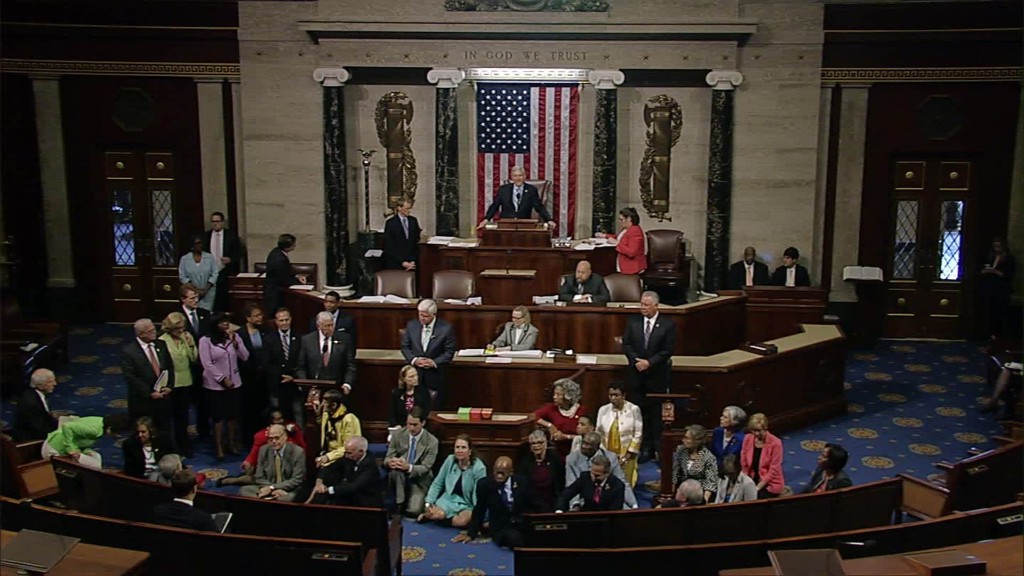
The U.S. Capitol is one of the most wired buildings on Earth, but on Wednesday cell phone camera feeds were the main way to see what was happening there.
As Democratic members of Congress staged a dramatic demonstration on the floor of the House of Representatives, seeking action on gun control legislation, the television cameras up in the balcony were restricted from showing the scene. That's because the cameras are operated and controlled by the government -- specifically, the Republican leaders of the House and the recording studio that works for them.
So Democrats live streamed the sit-in with their cell phones instead.
The protest action continued into the early hours of Thursday.
C-SPAN, CNN and other cable channels tapped into the congressional Periscope and Facebook Live streams in ways that weren't possible a decade ago.
Lawmakers also posted videos on Snapchat, uploaded photos to Instagram and sent out urgent tweets on Twitter. But it was Periscope that received the most media attention during the sit-in -- a fact sure to be celebrated by the app's owner Twitter (TWTR).
House Republicans sought to end the extraordinary day of drama in the early hours of Thursday morning by adjourning for a recess that will last through July 5.
Democrats, however, have promised to continue -- without TV cameras, lights or a legislative session. They'll publish the protest themselves, using the new digital methods.
The situation is unprecedented, according to longtime congressional correspondents.
Republican leaders have dismissed it as a "stunt" by Democrats. No matter what it's called, it is very well publicized.
When the act of congressional disobedience first began, House Speaker Paul Ryan said the House was in recess, and the TV cameras were turned off, in accordance with the rules governing House proceedings.
When the TV cameras were turned off, the phone cameras were turned on.
C-SPAN quickly tapped into the cell phone views from the floor in lieu of its usual top-down camera views. The videos were amateurish and the streaming signals were shaky. But the videos were embraced by social media users who wanted to see what was happening.
Related: House sit-in goes on as GOP holds votes
The legislators flouted longstanding rules against photo-taking inside the House chamber -- rules that pre-date the Periscope and Facebook Live era.
But the social media coverage of the demonstration showed that historical restrictions on access to the House and Senate chambers are no match for legislators' own smart phones.
Rep. Scott Peters was one of the impromptu hosts of the sit-in -- because he live-streamed scenes from the protest via the Periscope app, which is owned by Twitter (TWTR). Others preferred Facebook (FB) and Instagram.
The live feeds quickly racked up thousands of views.
At one point, Peters recommended to his colleagues that they download the necessary apps and start live-streaming, too.
And some of the Democrats turned the lack of traditional television coverage into a talking point.
"@HouseGOP turned off the cameras; see our #NoBillNoBreak sit-in live on my Facebook page," Rep. Barbara Lee tweeted.
A graphic on the bottom of C-SPAN's screen tried to explain the strange situation: "Democrats began sit-in at 11:25 am ET; House is currently in recess subject to call; House cameras are not permitted to show sit-in; Cameras in chamber controlled by House."
Oregon Democrat Earl Blumenauer argued (in a tweet) that the TV blackout "generated even more attention" for the Democrats' cause.
But the roles have been reversed in the past.
In 2008, when Republican legislators, then in the minority, held a protest on the floor, Democrats adjourned the House, causing the cameras and microphones to be turned off.
Back then, the protesters couldn't reach millions of people via social media. Times have changed. The C-SPAN arrangement, however, has not.
"All members of the House of Representatives voted on the rules governing floor proceedings at the beginning of the Congress," a House GOP leadership aide said Wednesday, and one of the rules stipulates that the TV cameras are "only on when the House is in session."
"This rule of the House is being enforced, as it has been since TV cameras were first installed in the House," the aide added.
The controversy with the cameras might have a silver lining at least from C-SPAN's perspective: Increased public awareness about how the cameras are actually operated.
C-SPAN spokesman Howard Mortman told Washingtonian that it was a "great teachable moment."
As for the blackout, C-SPAN's political editor Steve Scully was blunt in a tweet: "Blame Congress not C-SPAN."


